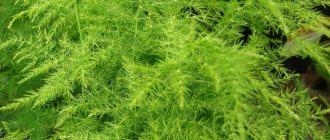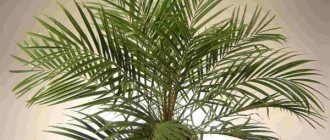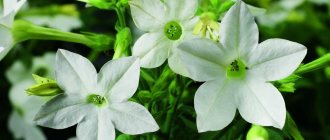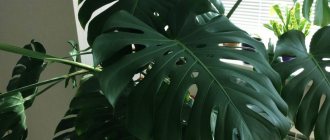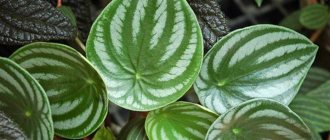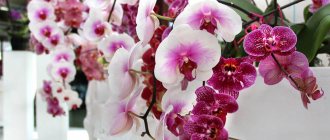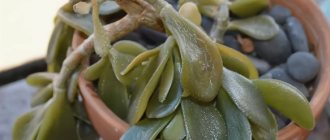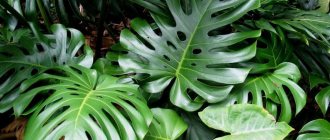Major diseases and shortcomings of care
Why do the tips of the date palm leaves dry out? Why do spots appear? Date palm ailments can be associated with both disease and poor care .
Fungal and viral diseases
Various pathogens
are to blame for date palm diseases :
- Fungi.
- Viruses.
- Bacteria.
Among fungal diseases, gray spot . Signs of the disease are gray spots on the leaves, more so on older ones. As the disease progresses, black spots appear - these are fungal spores.
For treatment , it is necessary to remove all infected parts before the disease affects the entire plant. Next, the palm tree is treated with fungicides - special antifungal drugs. The same remedies are also applicable for another, no less common fungal disease - pink rot.
Bacteria lead to putrefactive processes. They are characterized by soft stems and leaves, which also become discolored and fall off. The appearance of bacteria is promoted by increased soil moisture and keeping them in a cold room.
If a mosaic-type pattern appears on the leaves, this signals a viral infection. Most often, the plant is infected by insects , which must be promptly destroyed indoors. They may be:
- flies;
- mosquitoes;
- moths.
And other insects that can enter the room. For protection, mosquito nets should be installed on windows.
Once every six months it is necessary to carry out preventive treatment of plants with special chemicals.
Reasons for the loss of decorative appearance
Soil oversaturated with moisture can cause brown spots . Watering with cold water also leads to the same result.
Softening of the trunk , coupled with a putrid odor, also signals excess moisture, which threatens the life of the plant.
To check, you need to remove it from the pot and inspect it. If dead roots are found, you need to separate them from living ones and thoroughly clean them. Replant into another pot and into drier soil.
Date palm leaves are drying up, what should I do? If watering is insufficient, the leaves begin to wither and turn yellow . This may also be due to poor quality water - too hard or low in essential microelements.
But the same symptoms can also indicate too dense soil and associated moisture stagnation. The best solution in such a situation would be to replant into looser soil.
Brown coloring of the tips of the leaves is the result of insufficient air humidity. The same symptom is characteristic of hypothermia.
What is a mealybug?
The appearance of this pest cannot be confused with anything. This is a fairly large relative of the scale insect. The mealybug reaches up to 8 mm in length.
Female “hairy lice” have an undeveloped oval-shaped body, more typical of insect larvae. They lay numerous eggs in special sacs in the axils of the leaves. The shoots on which the pest lives are covered with a white, sticky waxy coating.
Males are not at all similar to females - they have wings and normally developed limbs, the body is divided into sections and ends in a bunch of tail filaments
Using their mouthparts, females and larvae easily pierce the surface of a leaf, bud or shoot and suck out the juices from it. Young scale insects are extremely mobile and easily move between plants. Sexually mature males do not feed because their mouthparts atrophy as they grow older.
Diseases and pests
The red spider mite is one of the main enemies of not only the date palm, but also many other indoor plants.
The size of the insect is only half a millimeter. It is bred in rooms with extremely low humidity and high temperature. It starts first in the stem, gradually spreading to the leaves.
Symptoms include gray or yellow spots and cracks. If no measures are taken, the green pet will die, completely covered in cobwebs. Particular attention should be paid in the spring, this is the time of the most likely infection.
The mealybug parasitizes leaves and young shoots, from which it sucks the juice. As a result of infection, the plant slows down its development and almost stops growing. The main symptom is a solid, cobweb-like white coating.
Thrips parasitize leaves, especially in their lower parts, laying eggs inside them. Damaged leaves become gray-brown in color and turn white at the top. Thrips can kill a plant: first the leaves turn yellow and fall off, and then the entire palm tree dries out.
The scale insect also feeds on plant sap and spreads very quickly. Insects gradually cover the entire palm tree, its surface becomes like tiny scales. As a result of loss of juice, the foliage withers and turns yellow, and the shoots may dry out.
The common spider mite parasitizes more than 200 species of cultivated plants, including the date palm. The insect damages the epidermis of the leaf and feeds on the sap of the plant, as well as chlorophyll grains. The leaf blade gradually darkens and dries out. Without treatment and insufficient watering, the plant dies.
When a palm tree turns into a pet zoo
Each plant needs special attention. For this reason, it is important to monitor your greenhouse closely every day. As a result, the florist will be able to notice the malicious pests of indoor palm trees in time. Often, parasitic insects differ in external characteristics. However, the harm they cause is almost the same.
Scale insect and false scale insect
If small tubercles/droplets (from 2 to 5 mm) of a brown hue appear on the leaves, it means that the scale insect has come to visit. Its diet is fresh plant juice. Because of this, the leaf area underneath them often becomes pale. If you remove them with your fingernail and crush them, thick yellow mucus will flow out from inside. Among other things, insects secrete a sticky coating in the form of white dots on the palm tree. Unfortunately, they can also appear on neighboring plants.
It is impossible to destroy the parasite with an insecticide, because it is protected by a dense shell. Therefore, it is better to use intestinal drugs. Ingestion of poisoned foliage leads to paralysis, and the scale insect eventually dies.
Some gardeners recommend treating the crop with an alcohol solution or water-oil emulsions. At the same time, you can replace the top layer of soil in the pot. Whether this will help or not largely depends on what stage of infection the flowerpot is at.
Mealybug
These insects are close relatives of the scale insect. Their diet is the same - the juice of the crop. They differ only in their oval shape (3-5 mm) and light color. The white larvae that appear on the palm tree quickly increase in number and begin to settle in:
- veins;
- ovaries;
- root system.
When using sprays, you must follow the instructions. If you bring the sprayer too close, the concentrated product can damage the leaf blades.
Parasites secrete a waxy sticky mass. Due to their active life activity, palm growth slows down. As a treatment you should try:
- regularly collect larvae;
- remove severely affected leaves;
- every 7 days, wash the greens with a soap or alcohol solution (often mixed with onion or garlic juice);
- use lepodocides - preparations of biological origin with toxic substances;
- use systemic insecticides that are absorbed by the crop and poison all the tissues of the flower (the bugs eat them and then die).
Preparations with biologically active substances are applied only to infected areas, which are the habitat of the colony.
It is impossible to single out any universal drug or method of control. Often you have to experiment and apply several methods in turn. Nevertheless, experience shows that palm diseases can be successfully combated at home. It is only important to diagnose them correctly.
Ways to combat parasites
To rid your green pet of parasite attacks, there are several methods. As a primary treatment, you can soap the sponge and remove insects. However, such a procedure is not able to completely defeat the infection, so radical measures are used. The following preparations are used for spraying :
- phosphamide;
- fitoverm;
- actellik;
- pyrethrum.
The proportion of the chemical solution is 2 g per 1 liter. water. It is advisable to spray once a week.
Traditional disinfection is also suitable: wipe the infected areas with a cotton swab soaked in alcohol and spray the rest of the plant.
The date palm has been known to man for more than 2000 years. As early as the sixth century BC, it was grown in Mesopatamia and in the territory of modern Iran. No less popular are indoor species, which can be grown from seeds without much difficulty.
Root mealybug
Most root scale insects belong to the genus Rhizoecus. This type of scale insects may not be noticed on the plant before transplantation, or they may be found near the roots, in the area of the root collar of the plant. Most often they harm cacti and succulents, but this is not necessary, they just often come from abroad from greenhouses with cacti, but they may well be found in other plants from the store.
Adult insects are about 2 - 5 mm long with an oblong or teardrop-shaped body. Segments and small bristles covered with a white waxy coating are clearly visible; the young colony consists of pests of different ages, as a rule, it looks like a very thick cobweb or pieces of cotton wool. Some people mistake the nests for salt deposits or mold. Just take a magnifying glass and take a closer look.
Affected plants lose almost their entire root system, so they immediately stop growing, the leaves turn yellow, dry out and die. Cacti affected by root worms slowly turn into a mummy - a withered, dirty gray stem, translucent spines. The plant will die if measures are not taken.
Control measures
As a pest prevention method, when replanting a plant, you need to carefully examine the roots. If pests are found, disinfect the pot (scald with boiling water), carefully clean the roots from the old soil, wash the plant roots in an insecticide solution and plant in fresh soil. If it is not possible to replant the flower, you need to water the ground with systemic insecticides that penetrate the vessels of the plant and cause the death of pests - these are actara and confidor.
Actara should be diluted as follows: 1 g of the drug per 10 liters of water. If you decide to replant, immerse the root part of the plant in the solution and soak for 5-7 minutes. If you have neither actara nor confidor, you can use any insecticide, for example, actellik, decis, karbofos. If the root system of the plant is fibrous, densely entwined with an earthen ball, then you need to prepare a solution and immerse the plant in it for 20 minutes (roots). Then dip into the solution several times along with the leaves. Leave to sit for 5-10 minutes, then rinse the plant under a warm shower.
Always sterilize the soil before planting any plants. Either in the microwave (for about 5 minutes 1 liter of soil) or in the oven on a baking sheet for about 20 minutes at 200 degrees.
- Forum thread about mealybugs
For health and freshness
How to rejuvenate a date palm? Renewal of the date palm consists of constant renewal of leaves that appear from above and die from below. It is necessary to remove fading or dried lower branches .
The top branches cannot be cut ! This can lead to the death of the plant. Drying of the upper branch is an unnatural process and signals a disease.
To give the plant freshness, the leaves need to be sprayed daily . Once a week, you can abundantly water the above-ground part of the plant, while covering the ground with film. It’s a good idea to wipe the leaves with a damp sponge; this will give the plant freshness and serve as additional prevention against parasites.
Harm to the plant
The mealybug literally sucks all the nutrients from the flowers, disrupting their growth and normal development. Sweet honeydew secreted by females provokes the development of associated fungal infections. Due to the sticky, impenetrable coating, the green pet's breathing becomes worse. This can cause the leaves to wilt and even fall off.
Mealy aphids (another name for mealybugs) do not prefer a specific part of the plant, attacking everything that comes in its way. Not only shoots, buds and leaves are under attack, but also roots. If treatment is not started as soon as possible, the bug will spread to surrounding indoor plants. In time he will destroy them all. Therefore, it is necessary to immediately declare war if you notice mealybugs on indoor plants. How to deal with the pest will be discussed below.
Date palm (date)
But the date is already a full-fledged real palm tree, drought-resistant, unpretentious, resistant to diseases and pests.
Everyone has seen the fruits of this tree in the store in the dried fruit section - orange or brown, sweet, high-calorie “berries”. By taking out a seed from them, you can easily grow a date palm at home. Separate the seeds from the pulp and place in a glass of water for 1-2 days, which you change with fresh water about once a day. After this procedure, remove the remaining pulp from the seed and safely plant it (vertically with the sharp end up) in specialized soil for palm trees to a depth of 3-4 cm. Cover the container with film or glass. Moisten the soil periodically, preventing it from drying out. In a couple of weeks, the sprouts of the future tree will hatch.
“Store” dried fruits are most often palmate date fruits. In fact, in nature this is a very tall tree, and in apartment conditions it will be extremely uncomfortable as it ages. Therefore, in order to save both yourself and the plant from further problems, it is best to purchase an “indoor palm tree” - the slow-growing dwarf Robelen date.
After the true leaves appear, pick up the seedlings into separate containers. It is better to place the plants on a western or eastern windowsill. As soon as the palm tree begins to grow, you can feed it with complex fertilizer. Watering should be regular, but not excessive.
- 22 plants that can be grown from seeds on the windowsill and in the garden
Familiar plants and exotic guests for home and garden.
The most common ailments of palm trees growing indoors
It is important to devote a little time to preventive measures that will protect your tropical pet from possible illnesses and diseases. However, they are not able to 100% eliminate the possibility of developing diseases and then the palm tree will need emergency help.
Violation of the watering regime and consequences
Palm trees love moisture, but not excessively; when the soil is overwatered, the tree begins to rot. Overdrying the soil is also dangerous; in this case, the leaves of the plant become pale, covered with spots, their growth stops and the blades wither. To avoid this, you should care for your exotic beauty properly:
- The crown of the palm tree should be sprayed with warm water daily.
- It is recommended to regularly wipe the leaves with a damp sponge or napkin, moistening them and removing dust and dirt. Caution must be exercised when performing the procedure on specimens whose leaves are covered with a waxy coating or hairs. If the covering is removed, the leaves will die.
- For irrigation and other activities, soft, settled water, slightly lukewarm or at room temperature, is used.
If the rules are not followed, you may encounter alarming symptoms and deterioration of the plant’s condition.
The appearance of brown spots on the foliage
Pigmentation can be different, initially small spots “blur”, occupying increasingly larger areas, their round shape becomes angular. The most common reasons for this:
- Overmoistening of the soil, stagnation of moisture in it.
- Watering palm trees with hard, cold water.
- Keeping the plant at low air temperatures.
You can improve the condition of a green pet only by adjusting the conditions of detention and correcting care errors. The amount of water introduced is reduced by 2 times; it is preliminarily settled or filtered rainwater is used. Damaged leaves are removed.
The appearance of spots and drying of leaves also occurs when the tree is infected with insect pests - spider mites or scale insects. In the latter case, the palm tree will be covered with the finest cobwebby coating.
To rid the plant of uninvited guests, you need to treat its leaves with a strong solution of laundry soap and repeat the procedure after a week. If the infection is severe, you will have to resort to more powerful insecticides. For example, you can use the drug Actellica for treatment. The crown is processed, and after 7-14 days the event is repeated for prevention.
Darkening of the foliage gives way to a whitish coating
These are signs of the dangerous fungal disease penicillosis, which is also called “white leprosy.” It develops when a plant is infected by spores of pathogenic fungi living in the soil. Moreover, despite the fact that pathogens are in the soil, the top of the palm tree is the first to suffer from their activity.
The disease can be identified by the following symptoms:
- Some parts of the foliage darken and dry out.
- After 7-10 days, the leaf blades become covered with a white coating.
- Severe deformation of the green mass occurs.
The main food for the fungus in the soil mixture is the remains of organic matter that has not had time to decompose. But when the plant’s immunity decreases, it weakens, the microorganism is activated and settles on young greenery. The following factors contribute to the development of the disease:
- Significantly increased humidity - up to 70% and above.
- The planted palm was already infected or damaged.
- The plant was kept indoors at an air temperature below + 15 degrees.
- The soil used is contaminated with fungal spores.
- Direct sunlight falls on the tree.
- The irrigation technology is broken - there is a high risk of penicillosis affecting the palm tree if moisture gets to its growth point.
Treatment of a room dweller begins with eliminating the causes that provoked the activity of the fungus. Then pruning of the above-ground parts affected by fungal spores is required. Fungicides are effective treatments for penicillosis.
To prevent illness from overpowering the exotic beauty, you should take care of the light and temperature conditions.
Yellowing or darkening of the foliage, further rotting of the tree. Often, infection of a plant by fungi leads to the development of various rots. Both the stem and the root system can rot. The main reason is abundant and frequent watering, leading to stagnation of moisture. Associated factors that aggravate the situation are a lack of minerals or sudden temperature changes.
The owner should be attentive to the exotic, since at the first signs of disease the palm tree will require transplantation:
- The green part of the tree withers and becomes drooping.
- Foliage color becomes yellow or dark.
Otherwise, the plant will begin to rot and then it will not be possible to cure it. Resuscitation measures consist of the following procedures:
- The soil should be shed.
- Carefully remove the specimen from the pot.
- The earthen ball is removed, the root system must be carefully examined and damaged and affected parts must be removed.
- The palm tree is placed in a solution of fungicide with zinc or copper for a quarter of an hour.
- The sections are sprinkled with charcoal; you can use activated or wood charcoal. Some gardeners sprinkle them with ground cinnamon powder.
- A fresh substrate is being prepared; it should be sterilized in the oven or disinfected by spilling it with a solution of potassium permanganate.
- When the tree is planted, the soil is watered with water and a fungicide solution. After 5-7 days the procedure is repeated.
Liviston
In nature (Asia, Africa, Australia), these widespread palm trees grow up to 25 m in height, and their gray-green glossy fan leaves on long petioles with thorns reach more than 1.5 m in width (in some places in their homeland even used as umbrellas).
Only a few types of Liviston are suitable for apartment conditions - southern, round-leaved, Chinese - and they can grow above 3-4 m. These palms love bright diffused light, watering with warm water, high air humidity and fairly moderate temperatures (about 20 ° C in summer and about 16°C in winter). In the warm season, it is useful to take these plants (like the vast majority of indoor palm trees) out into the fresh air (into the garden or at least onto the balcony); in the cold season, they need to have a dormant period, reducing watering, reducing light, temperature and air humidity.
Livistons reproduce only by seeds. When transplanting adult and especially young plants, it is extremely important not to damage their long roots - otherwise the death of the tree almost 100% occurs.

